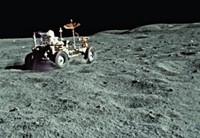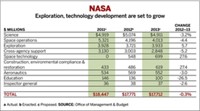Advertisement
Grab your lab coat. Let's get started
Welcome!
Welcome!
Create an account below to get 6 C&EN articles per month, receive newsletters and more - all free.
It seems this is your first time logging in online. Please enter the following information to continue.
As an ACS member you automatically get access to this site. All we need is few more details to create your reading experience.
Not you? Sign in with a different account.
Not you? Sign in with a different account.
ERROR 1
ERROR 1
ERROR 2
ERROR 2
ERROR 2
ERROR 2
ERROR 2
Password and Confirm password must match.
If you have an ACS member number, please enter it here so we can link this account to your membership. (optional)
ERROR 2
ACS values your privacy. By submitting your information, you are gaining access to C&EN and subscribing to our weekly newsletter. We use the information you provide to make your reading experience better, and we will never sell your data to third party members.
Policy
Funding Science At NASA
National Academies report finds the agency trying to do too much with too little
by Susan R. Morrissey
May 22, 2006
| A version of this story appeared in
Volume 84, Issue 21

The National Aeronautics & Space Administration has a lot on its plate right now. It's being asked to get the space shuttle fleet flying again, finish the International Space Station, develop new spacecraft to replace the aging shuttles, prepare for lunar missions, and maintain its vigorous science programs. It is to do all this on a budget that's expected to grow by only 3.2% in 2007 to $16.8 billion.
A report from the National Academies, however, finds that NASA is being asked to do too much with too little; that is, the agency lacks the resources to achieve its set goals. The congressionally mandated report, "An Assessment of Balance in NASA's Science Programs," was released on May 4 and concludes that the agency's science programs are being cannibalized to fund the exploration goals set by the President's Vision for Space Exploration, which was rolled out in January 2004 and targets a return to the moon by 2020.
"There is a mismatch between what NASA has been assigned to do and the resources with which it has been provided," report committee Chairman Lennard A. Fisk, space science professor at the University of Michigan, said in a statement. "We are particularly concerned that the shortfall in funding for science has fallen disproportionately on small missions and on funding for basic research and technology. These actions run the risk of disrupting the pipeline of human capital and technology that is essential for the future success of the space program," he explained.
The committee that wrote the National Academies report reviewed NASA's plans for research programs over the next five years in six areas: astrophysics, heliophysics, planetary science, astrobiology, earth sciences, and microgravity life and physical sciences.
In addition to finding that the proposed budget allocations for NASA would not allow the agency to accomplish all of its current goals, the report calls on the agency to reconstitute advisory committees to help it balance its science programs.
The report also warns that under the current plans, NASA's space and earth sciences program will not be robust. To correct this weakness, the report advocates a return of small missions to NASA's mix of moderate-size and large missions, which the report projects would cost about 1% of the total NASA budget in the short term. The report also calls on NASA to do a cost-to-complete evaluation of missions under development in this area.
With respect to the microgravity life and physical sciences program, the report finds severe reductions. On the basis of NASA's budget estimates, the report notes, funding in this area will be reduced by 69% for the period 2007 to 2011, dropping by $3.8 billion from the original budget plan of $5.5 billion to only $1.7 billion for the five-year period. Under NASA's current plan, the annual funding for microgravity research through 2011 would range from $275 million to $312 million per year, down considerably from the 2005 level of $910 million.
In light of this drastic cut to future microgravity life and physical sciences research, the report recommends that NASA "preserve the essential ground-based and flight research that will be required to enable long-duration human space flight and continue to foster a viable community that ultimately will be responsible for producing the essential knowledge required to execute the human space-flight goals of the Vision." The report notes that maintaining the necessary research in the short term would require resource allocations of less than 1% of the total NASA budget.
The findings of the report echo issues raised by members of Congress who watch over NASA. "I requested this report because I was concerned about the future of NASA's science programs," Sen. Barbara A. Mikulski (D-Md.) said. "Unfortunately, this report confirms what I have long feared-that science programs are threatened by budget cuts and poor planning," she said, adding that this conclusion should be a wake-up call for the agency.
Sharing Mikulski's concern is House Science Committee Chairman Sherwood L. Boehlert (R-N.Y.), who said in a statement that "we should not be satisfied with a fiscal 2007 budget that provides less for science than was provided in FY2005." He notes that he will work with the Appropriations Committee to try to improve the funding for science at NASA but acknowledges that finding additional funds will be difficult in this tight budget year. In any case, he maintains that "NASA needs to remain a multimission agency."
NASA, which has been addressing the issue of science funding since the fiscal 2007 budget was released in February, acknowledges that it was forced to dip into science funding to push forward on its exploration objective. "The plain fact is that NASA simply cannot afford to do everything that our many constituencies would like the agency to do," NASA Administrator Michael D. Griffin said at a February House Science Committee hearing.




Join the conversation
Contact the reporter
Submit a Letter to the Editor for publication
Engage with us on Twitter